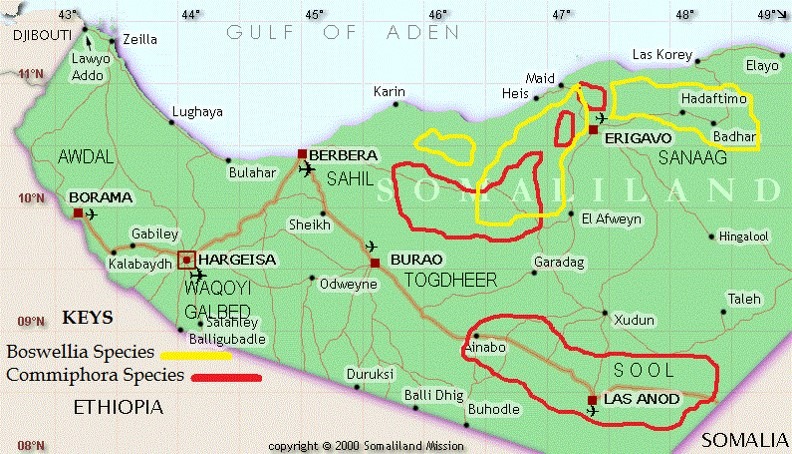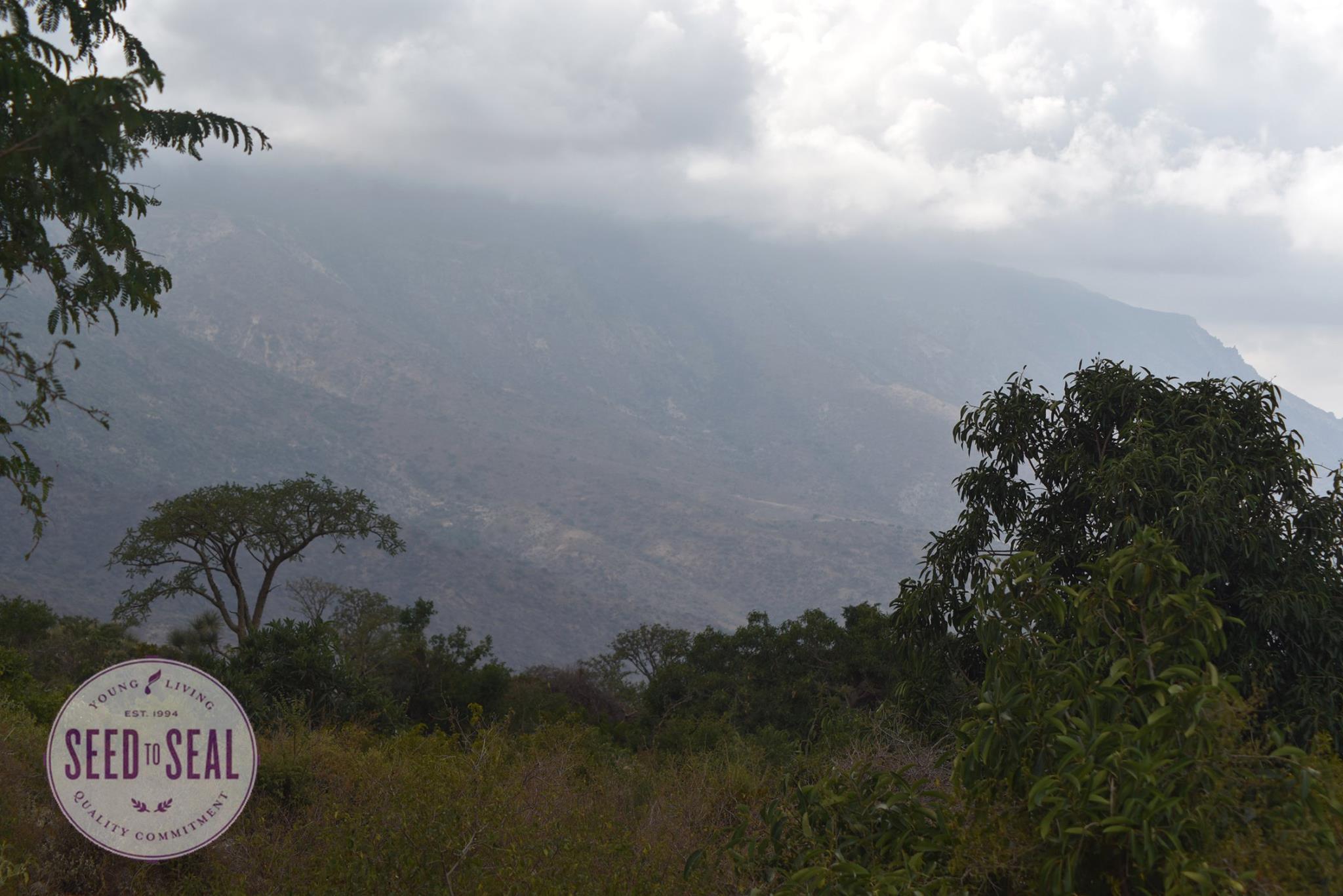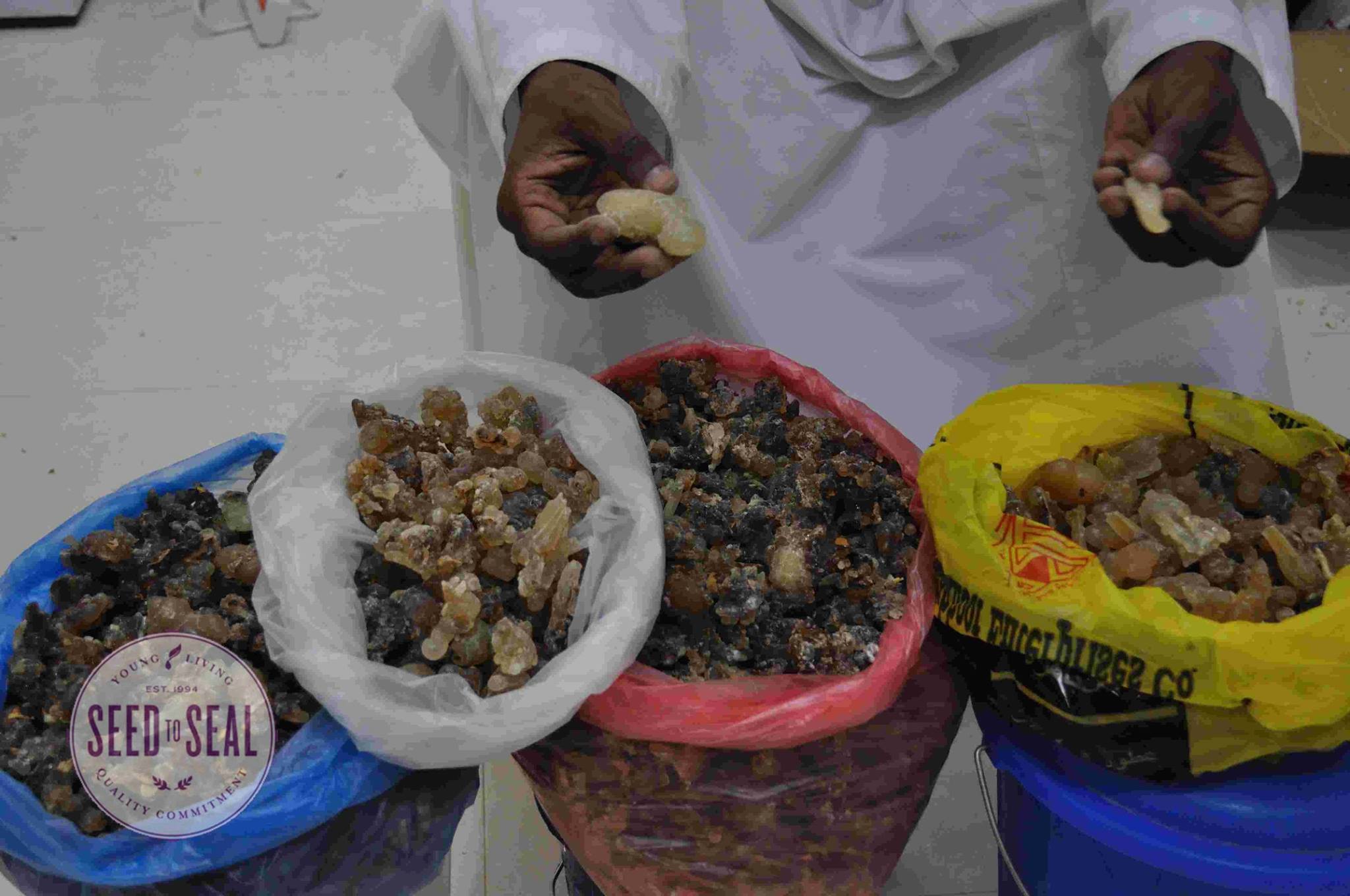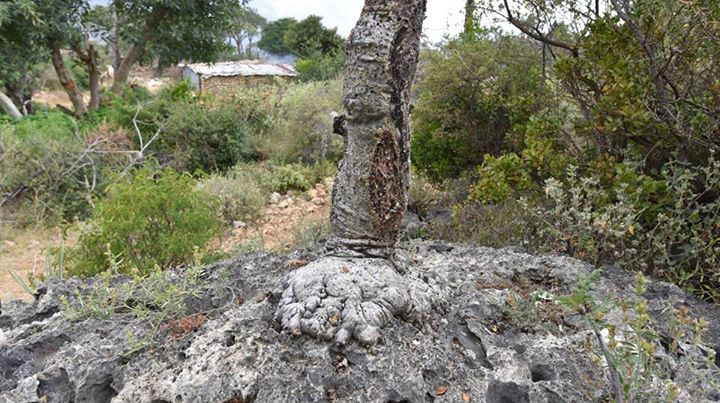 Somaliland is located in the north of Somalia. It is the horizontal portion of the country that looks like the number 7. Somaliland is north of Ethiopia and contains the highest mountains. The mountains of Somaliland are high enough that streams flow year round. Somaliland mountains are often covered with morning clouds and evening rains.
Somaliland is located in the north of Somalia. It is the horizontal portion of the country that looks like the number 7. Somaliland is north of Ethiopia and contains the highest mountains. The mountains of Somaliland are high enough that streams flow year round. Somaliland mountains are often covered with morning clouds and evening rains.

Somaliland mountains where Frereana Frankincense loves the moist air and limestone soil.
Puntland is located on the northeast of the country in the corner of the number 7. Puntland receives most of its rain during the monsoon season through the months of June and Sep each year. Puntland is the “country” that the Egyptians mentioned as the source of frankincense nearly 4000 years ago.
Source: Dr Cole Woolley PhD, February 24, 2015
 There are 2 species of frankincense that grow in Somalia. Boswellia carterii grows in Somaliland and Puntland closer to the sea and in the hills.
There are 2 species of frankincense that grow in Somalia. Boswellia carterii grows in Somaliland and Puntland closer to the sea and in the hills.
Boswellia frereana grows mainly in Somaliland high in the mountains farther away from the sea.
 Both frankincense species have found valuable places in the markets of Arabia, Middle East and throughout the world. Boswellia carterii is harvested twice each year; once in the Spring (February/March) and once in the Fall (August/September). Boswellia frereana is harvested only once per year, but over a 9 month period
Both frankincense species have found valuable places in the markets of Arabia, Middle East and throughout the world. Boswellia carterii is harvested twice each year; once in the Spring (February/March) and once in the Fall (August/September). Boswellia frereana is harvested only once per year, but over a 9 month period
Source: Dr Cole Woolley PhD, February 25, 2015

Boswellia frereana resin collection and harvesting at our new Young Living Somaliland cooperative Farm. Frereana resin is collected over a 9-month period. Collection of the large frereana resin slab takes place in May/June each year.
How is Carterii Frankincense resin harvested from the Boswellia carterii tree?
In the Springtime (Feb/Mar) Somali men harvest carterii resin from the Sunset side of the tree, while in Autumn they harvest from the Sunrise side of the tree.
This helps the tree heal over a 12 month period and allows collecting resin twice per year. Carterii resin is collected every 2 weeks after the bark is initially scored.
The gum-resin is collected 3 and sometime 4 times every 2 weeks. The gum-resin is collected in woven baskets and kept in cool, dry caves or in cool, dry huts.
Some of the essential oil evaporates from the resin which causes a separation of conglomerate pieces into their individual forms. This drying process has been going on for 5000 years.
Source: Dr Cole Woolley PhD, February 26, 2015
 Frereana gum is mainly used as a chewing gum. Most of the large slabs are sold in Saudi Arabia and the Emirates for an after-meal refreshing chew. The gum-resin becomes a soft, white chewy gum in the mouth within 15 seconds.
Frereana gum is mainly used as a chewing gum. Most of the large slabs are sold in Saudi Arabia and the Emirates for an after-meal refreshing chew. The gum-resin becomes a soft, white chewy gum in the mouth within 15 seconds.
The Frereana gum refreshed the breath. Each Frereana slab is expensive – about $100 USD. Each person only needs a small piece of Frereana gum to enjoy a flavorful chew.
Source: Dr Cole Woolley PhD, February 27, 2015

Gary Young exploring Somaliland frankincense trees in Oct 2013.
Frereana gums come in 6 grades.
Grade 1 and Grade 2 are largest pieces of slabs. Grade 1 and Grade 2 Frereana resins are sold at high prices ($100.00/slab) as chewing gums. Grades 3 and 4 are smaller pieces of the gum slabs – usually larger than the larger coin.
Young Living distills Grades 3 and 4 Frereana gums. Grades 5 and 6 are waste gum from scraping bark off the gum slabs.
The Frereana essential oil from Grades 1-4 are biochemically similar, but may vary by the quantity of oil in the gum. Grades 5 and 6 produce an essential oil that is lower in quality and not very indicative of the gum aroma. Young Living does not use Grades 5 and 6 gums.
Source: Dr Cole Woolley PhD, February 28, 2015

Color is a significant factor in judging the quality of frankincense resin. Image Source
Grade 5 and 6 Frereana gum-resins are mainly used in Egyptian Coptic churches for ceremonial incense burning. The Coptics have used Frereana gum-resins for nearly 2000 years.
The Frereana gum resins (especially Grade 1) is often referred to as the “King of Frankincense” because of the large size of the gum-resin.
The Coptics and Somalians consider Frereana Frankincense as the most valuable and believe that this was the frankincense type given to the baby Jesus.
Source: Dr Cole Woolley PhD, February 28, 2015
 In the ancient place known as Puntland, the Egyptians sought to collect frankincense resin for their Pharoah. Today, the region east of Somaliland is known as Puntland by the locals. Both regions have declared independence from Somalia.
In the ancient place known as Puntland, the Egyptians sought to collect frankincense resin for their Pharoah. Today, the region east of Somaliland is known as Puntland by the locals. Both regions have declared independence from Somalia.
Puntland is the source of Boswellia carterii frankincense trees. The gum is harvested twice each year. My good friend Hassan took this photo in January. Hassan’s family is from Somaliland where the Boswellia frereana grows in abundance.
Note how the frankincense tree grows roots through the limestone ground. Frankincense loves limestone. The Dhofar Mountains near Salalah, Oman were Boswellia sacra grows are limestone cliffs. That is one reason Boswellia sacra grows so well in this region of Oman.
Source: Dr Cole Woolley PhD, July 5, 2015
